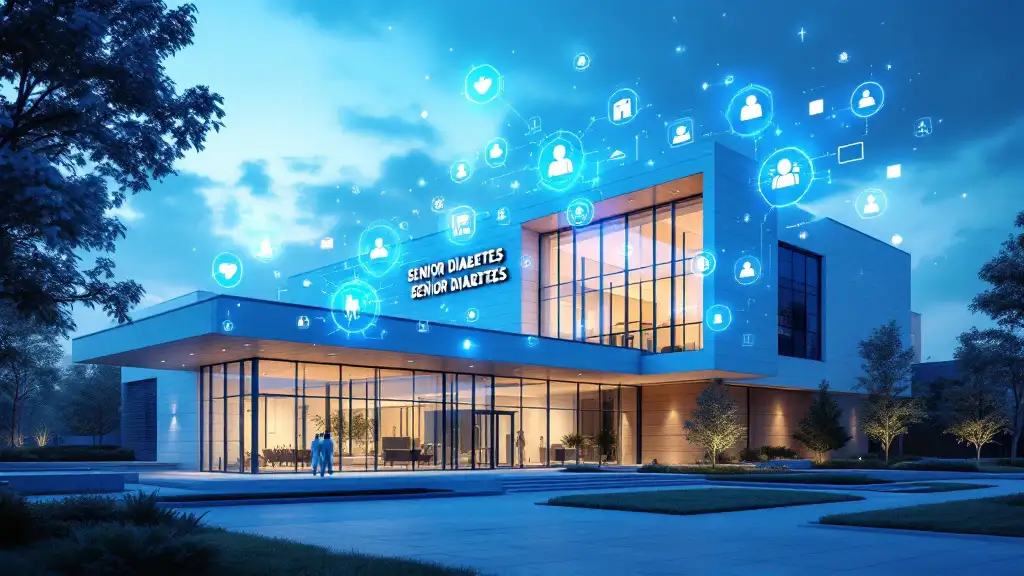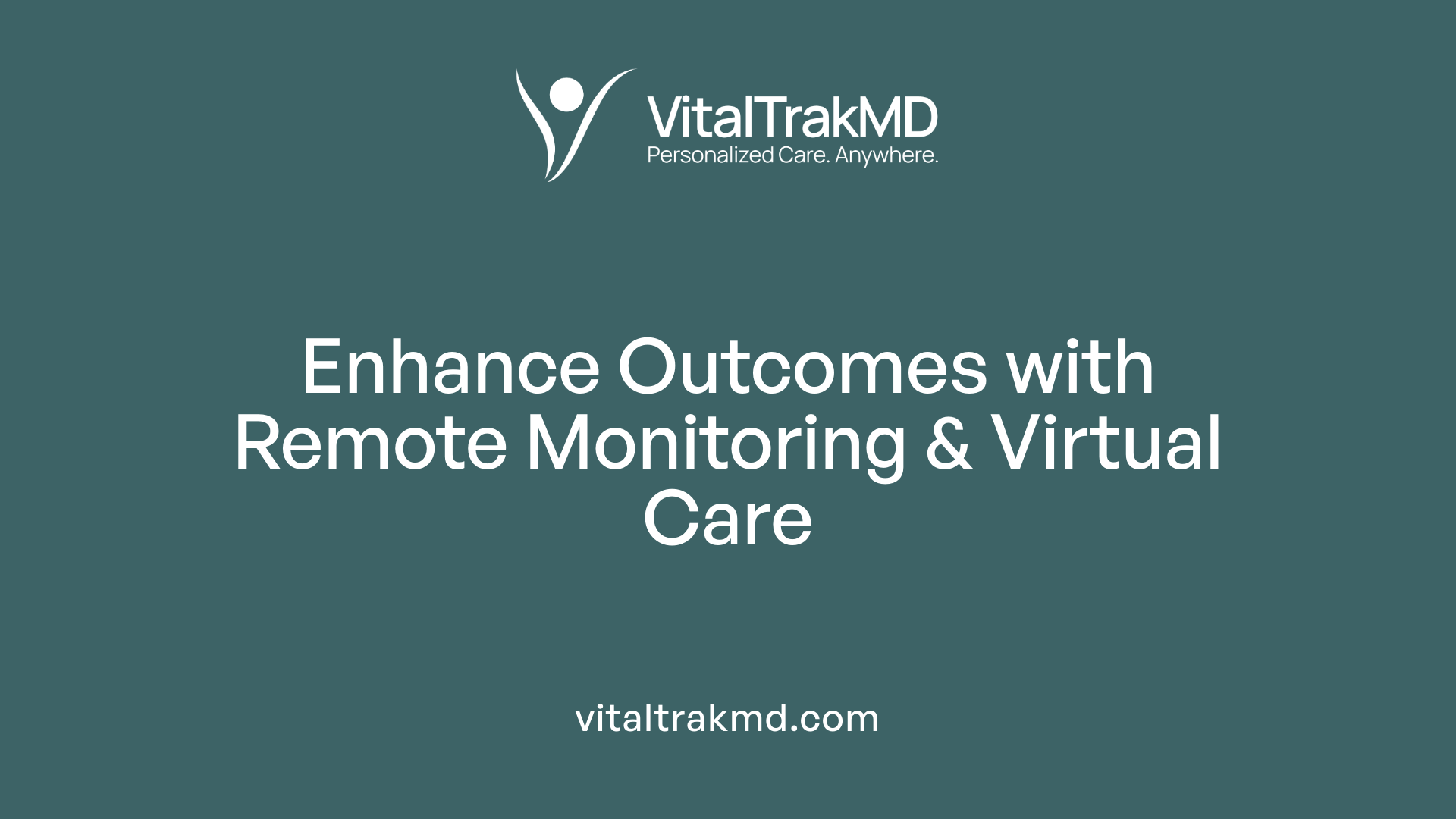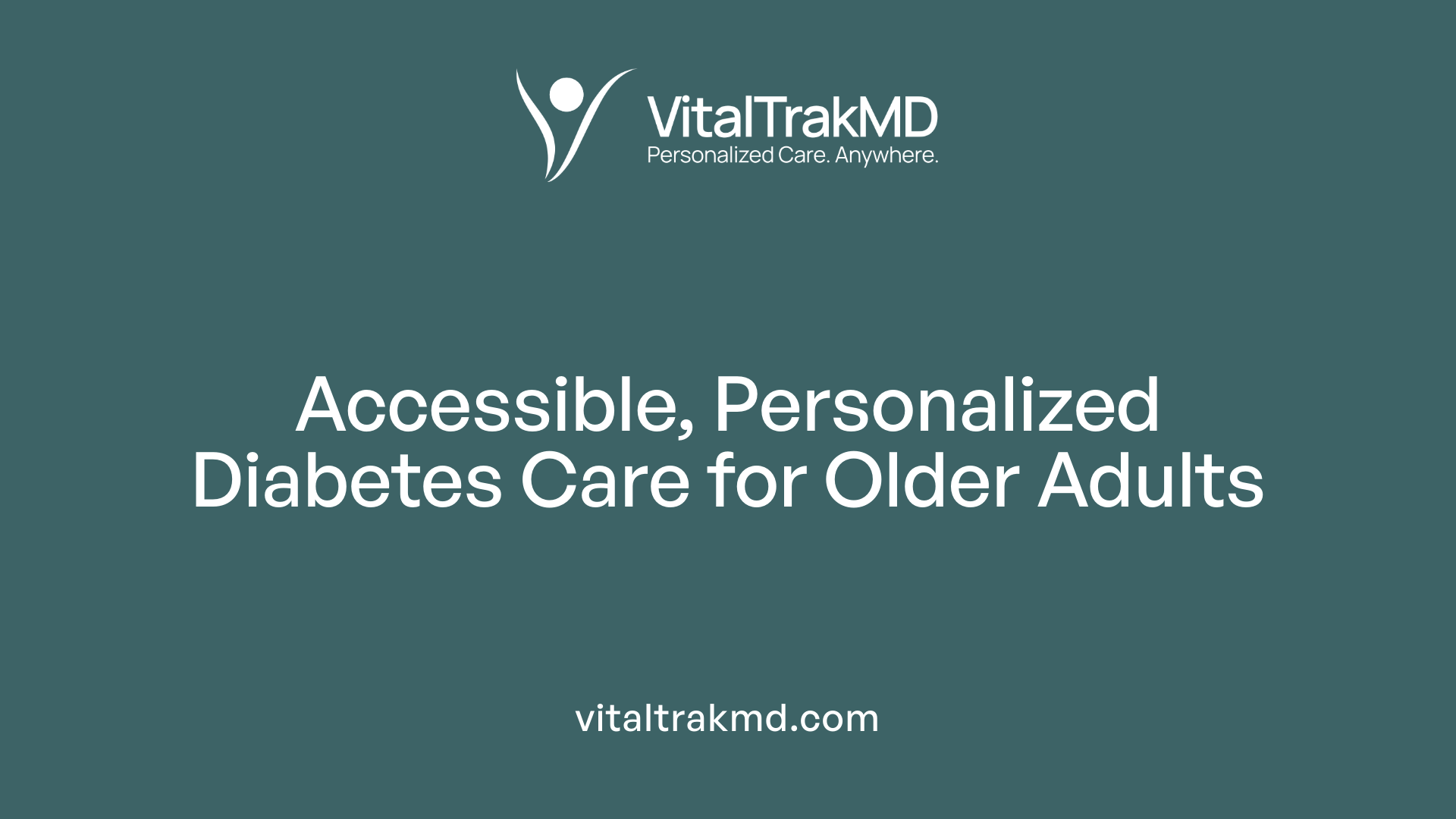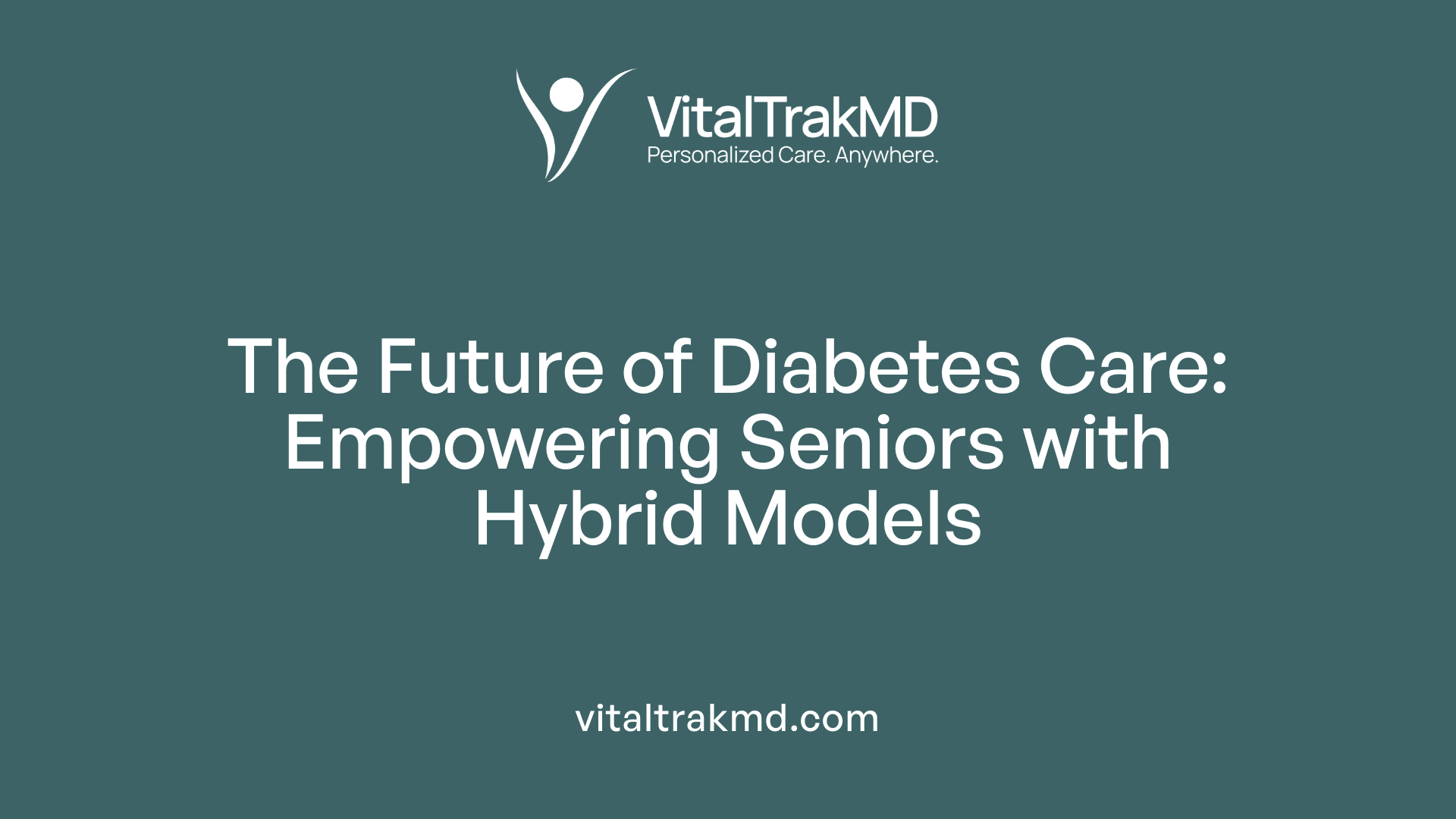How Hybrid Care Enhances Quality of Life for Seniors with Diabetes

Introducing the Power of Hybrid Care Models in Enhancing Elderly Well-being
As the prevalence of diabetes continues to rise among older adults, innovative approaches to management become vital. Hybrid care models, integrating in-person visits with telemedicine and digital health tools, are transforming how seniors maintain their health, empowering them with personalized, accessible, and effective care options. This article explores how these models improve clinical outcomes and enrich quality of life for seniors living with diabetes.
Understanding Hybrid Care in Diabetes Management
What are the benefits and effectiveness of combining in-person and telemedicine approaches in senior diabetes management?
Hybrid care models, which blend traditional face-to-face visits with telemedicine and digital health tools, are transforming diabetes management, especially for older adults. These models combine the benefits of personal interaction with the convenience and continuous support offered by remote technology.
One major advantage is improved access to healthcare services. Many seniors face barriers such as transportation issues or geographical limitations, which can restrict regular visits to healthcare providers. Telemedicine allows patients to receive expert guidance without the need to travel, ensuring consistent care.
Studies demonstrate that hybrid approaches significantly improve glycemic control. For example, in controlled trials, patients managed with hybrid models experienced reductions in HbA1c from around 10.47% to 7.87%, a meaningful decline indicative of better blood sugar regulation. Such improvements are often associated with a lowered risk of complications.
Remote monitoring tools, like continuous glucose monitors (CGMs), enable real-time data sharing with healthcare providers. This ongoing engagement allows for timely medication adjustments, personalized education, and behavioral support tailored to each patient's needs.
The effectiveness of hybrid models surpasses traditional care. Patients engaged in these programs typically show greater adherence, improved clinical markers, and higher satisfaction. For instance, some programs reported HbA1c reductions of over 2% and weight loss, alongside better lipid profiles and cardiovascular risk measures.
Moreover, during the COVID-19 pandemic, telehealth became crucial in maintaining care continuity. Diabetes educators can provide personalized support via video calls or messaging, reinforcing self-care practices and medication management.
By integrating digital health tools with in-clinic visits, hybrid care models foster patient empowerment and active disease management. This approach also supports mental health by reducing diabetes distress and fear of hypoglycemia, common concerns among seniors.
In summary, the combination of in-person and digital healthcare approaches offers a flexible, effective, and patient-centered framework. It enhances clinical outcomes, reduces unnecessary hospital visits, and promotes a better quality of life for older adults managing diabetes.
How do digital tools and remote data monitoring enhance senior diabetes management?
Digital tools, such as mobile apps, telehealth platforms, and remote continuous data monitoring devices, play a vital role in modern diabetes care. For seniors, these technologies facilitate greater engagement in self-management and provide healthcare providers with timely insights.
Remote continuous data monitoring allows for ongoing assessment of blood glucose levels, enabling proactive adjustments to therapy. Patients receiving regular feedback tend to have improved HbA1c and fewer episodes of hyper- or hypoglycemia. The use of CGMs, in particular, has been shown to reduce glycemic variability and enhance overall control.
Digital platforms also support behavioral changes by delivering personalized educational messages, appointment reminders, and medication prompts. These interventions have been linked to improved adherence and lifestyle modifications.
Incorporating these tools into routine care can help identify cognitive or physical challenges early, allowing for intervention before complications develop. Telehealth also allows caregivers and family members to participate actively, supporting the patient’s health journey.
While promising, integrating technology requires addressing barriers such as digital literacy, access to devices, and health disparities. Tailored education and caregiver involvement are essential to maximize benefits.
What are some challenges and considerations in deploying hybrid care models for elderly patients?
Implementing hybrid care models must be individualized, considering the health status, cognitive function, and social support systems of older adults. Some seniors may face difficulties with adopting new technologies due to limited digital skills or cognitive impairments.
Structural barriers, such as limited internet access or financial constraints, may hinder the widespread use of digital health tools. Healthcare providers need to assess each patient’s capacity for technology use and provide appropriate education or alternative solutions.
Caregiver involvement is critical, especially for those with functional limitations. Support from family or community resources can facilitate technology adoption and adherence.
In long-term care settings, deploying these models requires coordination with staff and considerations for privacy and data security. Additionally, the healthcare system should ensure training for providers to effectively utilize telehealth platforms.
Despite these challenges, personalized hybrid approaches can significantly improve health outcomes and quality of life. Strategic planning, patient education, and resource allocation are vital for successful deployment.
| Aspect | Benefit/Challenge | Additional Details |
|---|---|---|
| Access to care | Improved | Telemedicine reduces transportation barriers and clinic load |
| Clinical outcomes | Enhanced | Significant HbA1c reductions, weight loss, better lipid control |
| Patient engagement | Increased | Higher satisfaction, adherence, and empowerment |
| Mental health | Supportive | Reduced diabetes distress and hypoglycemia fear |
| Technology barriers | Challenge | Digital literacy, access, and privacy concerns |
| Caregiver support | Essential | Facilitates tech adoption and ongoing assistance |
Impact of Hybrid Care on Glycemic Control and Clinical Outcomes
What research has been conducted on hybrid care models' influence on health outcomes and quality of life in senior diabetic populations?
Research exploring hybrid care systems for older adults with diabetes shows promising results in improving health outcomes and quality of life. These models combine in-person medical visits with telemedicine, remote monitoring, and digital engagement tools to provide continuous, personalized care.
For example, a study involving 181 patients with uncontrolled type 2 diabetes across three centers in Riyadh, Saudi Arabia, revealed that a hybrid approach significantly lowered HbA1c levels — from 10.47% at baseline to 7.87% after an average of four months (p<0.001). This indicates improved glycemic control through combined care modalities. In Dubai, another study of 180 patients using a hybrid model found HbA1c reductions of up to 2.19%, along with improvements in weight, BMI, cholesterol profiles, and cardiovascular risk markers.
Similarly, research involving 120 adults with type 1 diabetes utilizing a six-month hybrid closed-loop system noted enhanced diabetes-specific well-being and reduced distress related to hypoglycemia. Participants reported feeling less worried about blood sugar lows and exhibited better overall mental health scores.
These studies collectively demonstrate that hybrid models bolster not just clinical metrics but also psychological health. They facilitate greater patient engagement through regular digital communication, personalized education, and insulin management support, especially vital during pandemic conditions like COVID-19, where in-person visits may be limited.
Notably, patients with higher engagement levels—defined as 11 or more interactions over 90 days—experienced even more pronounced improvements. This shows the importance of ongoing participation and digital literacy in maximizing benefits.
The integration of remote continuous data monitoring (RCDM) allows care teams to track blood glucose levels and health parameters in real time, facilitating timely interventions. Digital tools support behavioral changes, reinforce self-care, and help manage comorbidities, all contributing to better quality of life.
Overall, current research indicates that hybrid care models are effective in managing diabetes among older populations. They lead to meaningful reductions in HbA1c, weight, and cholesterol while improving mental health and self-management capacity.
How do continuous data monitoring and patient engagement impact health outcomes?
Continuous data monitoring (CDM) plays a crucial role by providing real-time feedback on blood glucose levels, enabling timely insulin adjustments and lifestyle interventions. When combined with active patient engagement, it fosters a sense of control and adherence to treatment plans.
Studies highlight that patients who actively participate in their care—such as those with frequent interactions—tend to achieve better clinical results. For example, a study reported that patients with frequent digital interactions saw a 2.38% reduction in HbA1c and a 6 kg weight loss. This self-monitoring empowers patients, enhances adherence, and encourages behavioral changes.
Furthermore, digital support tools reinforce education, improve self-care practices, and promote motivation. Telehealth messaging, for instance, has shown to improve blood pressure control, indicating broader cardiovascular benefits.
The role of patient engagement is especially important among older adults, who often face barriers such as limited digital literacy or technological skepticism. Tailored support, caregiver involvement, and user-friendly interfaces can enhance technology use and health outcomes.
In conclusion, integrating continuous data monitoring with active patient engagement significantly boosts glycemic control, reduces complications, and elevates overall quality of life for seniors with diabetes.
| Aspect | Impact | Explanation |
|---|---|---|
| HbA1c reduction | Significant | Decreases range from 0.82% to 2.19% in various studies |
| Weight loss | Up to 6 kg | Linked to improved metabolic health |
| Cholesterol improvements | LDL and total cholesterol decrease | Reduces cardiovascular risk |
| Mental health | Enhanced scores, reduced distress | Addresses psychological aspects |
| Engagement levels | Greater interaction, better outcomes | More digital interactions correlate with HbA1c drops |
| Technology role | Real-time monitoring | Enables timely interventions |
| Caregiver support | Improved adherence | Facilitates technology adoption |
Which aspects of hybrid diabetes care most influence outcomes?
Hybrid diabetes care's impact depends on several factors. High patient engagement and consistent use of monitoring tools are crucial. Patients who actively leverage digital communication, participate in education programs, and adhere to insulin titration plans report greater improvements.
The effectiveness is also linked to the personalized approach, incorporating mental health support and behavioral coaching.
Technology accessibility, caregiver involvement, and tailored education further enhance success.
Overall, combining technological tools with active patient participation creates a powerful approach to managing diabetes in older populations, leading to better clinical measures and improved quality of life.
Benefits of Remote Monitoring and Virtual Interactions

How does remote monitoring and virtual interactions enhance health outcomes for seniors with diabetes?
Implementing remote monitoring and virtual healthcare interactions has proven to significantly improve health outcomes among seniors living with diabetes. These digital tools enable continuous tracking of blood glucose levels, blood pressure, weight, and other vital signs, providing real-time data to healthcare providers.
This continuous flow of information allows for timely interventions, such as medication adjustments or lifestyle recommendations, often before complications develop. For example, studies have shown that using telemedicine for diabetes management can result in reducing HbA1c levels by over 1%, indicating better glycemic control.
Many patients, especially older adults, face barriers to frequent in-person visits due to mobility issues or geographic constraints. Virtual interactions help bridge this gap, ensuring consistent care and support. These platforms also foster better medication adherence by enabling remote coaching, medication reminders, and direct communication with healthcare teams.
Research highlights that hybrid models combining in-person visits with telemedicine are particularly effective for seniors with complex health needs. They reduce hospitalizations, improve self-management skills, and contribute to a better quality of life.
Moreover, the integration of remote monitoring can support behavioral change, promote physical activity, and facilitate mental health management—factors critical to overall health in aging populations. In summary, adopting these technologies reduces healthcare costs, enhances proactive disease management, and ultimately leads to improved health and well-being among seniors with diabetes.
| Aspect | Benefits | Additional Notes |
|---|---|---|
| Continuous Tracking | Real-time health data collection | Enables early detection of issues |
| Timely Intervention | Prompt healthcare responses | Reduces risk of complications |
| Medication Adherence | Improved compliance | Through reminders and remote coaching |
| Lifestyle Support | Encourages healthy habits | Behavioral change facilitation |
| Reduced Clinic Visits | Less travel and wait time | Cost and time savings |
| Holistic Care | Integrates physical and mental health | Supports overall well-being |
Digital Health Interventions and Their Role in Diabetes Care
What is the impact of digital health interventions, like telehealth, on managing diabetes and improving seniors' well-being?
Digital health interventions have revolutionized the management of diabetes, especially among older adults. Technologies such as telehealth, continuous glucose monitoring (CGM), insulin pumps, and mobile health applications play a crucial role in offering more effective, personalized care.
Telehealth enables remote consultations, allowing healthcare providers to monitor patients' blood glucose levels, adjust medications, and provide education without the need for frequent in-person visits. This approach is particularly beneficial for seniors who may face mobility or transportation issues, or during situations like the COVID-19 pandemic.
CGM devices provide real-time glucose data, helping both patients and healthcare providers track trends and make timely adjustments. Insulin pumps and hybrid closed-loop systems automate insulin delivery, reducing the burden of daily management and minimizing hypoglycemic events.
Mobile apps support self-management by offering medication reminders, dietary guidance, physical activity tracking, and mental health support. These tools foster greater patient engagement and adherence, leading to better glycemic control.
Studies have shown that integrating these technologies results in significant improvements in HbA1c levels, weight management, lipid profiles, and overall cardiovascular risk. For example, hybrid models combining in-person care with remote monitoring reduced HbA1c by over 2% in some cases, facilitating the achievement of target levels (<7%) that decrease complication risks.
Furthermore, digital interventions can positively influence mental health by reducing diabetes-related distress and fear of hypoglycemia. So, these innovations go beyond physical health, enhancing overall well-being.
However, adopting these technologies among older adults comes with challenges. Limited digital literacy, lack of reliable internet access, cognitive or physical impairments, and insufficient caregiver support can hinder effective use. Overcoming these barriers requires tailored education, involving caregivers, and developing user-friendly tools.
In summary, digital health interventions significantly enhance diabetes management in seniors by enabling continuous care, promoting behavior change, and addressing the complexities of aging and chronic disease. When successfully tailored and supported, they contribute substantially to improving quality of life and health outcomes for this vulnerable population.
Advantages of Hybrid Care Approaches, Including Closed-Loop Therapy

What are the specific advantages of hybrid care approaches, including hybrid closed-loop therapy, for seniors with diabetes?
Hybrid care approaches, such as hybrid closed-loop (HCL) systems, bring notable benefits to older adults managing diabetes. These systems automatically deliver insulin based on real-time continuous glucose monitoring (CGM) data. As a result, they improve blood glucose control by increasing the time patients spend within their target range.
One of the most significant advantages is the reduction in hypoglycemia incidents. Since the system continuously adjusts insulin delivery, the risk of dangerously low blood sugar levels drops, which is especially important for seniors who may be more vulnerable to severe hypoglycemia.
Research shows that seniors using hybrid closed-loop systems achieve better glycemic outcomes, with improvements in glucose variability and overall control. Additionally, these advanced systems lessen the burden of frequent fingerstick testing and constant manual adjustments, fostering greater independence in daily management.
Older adults often face challenges like limited stamina or cognitive decline. Hybrid systems support these needs by easing routine tasks, helping seniors maintain a more active and autonomous lifestyle. They can also slow the progression of diabetes-related complications, potentially preserving functional health longer.
However, successful integration of technology depends on addressing certain barriers. Digital literacy, affordability, and access disparities can limit the widespread use of hybrid systems among seniors. Tailoring these tools to individual health statuses, cognitive abilities, and social circumstances is essential.
Incorporating personalized education, caregiver involvement, and user-friendly interfaces enhances usability. When implemented thoughtfully, hybrid closed-loop therapy can significantly uplift the quality of life for seniors, supporting better health outcomes while preserving independence.
Supporting Accessible and Patient-Centered Care through Hybrid Models

How does hybrid care integration support accessible, effective, and patient-centered diabetes management for older adults?
Hybrid care models combine traditional in-person visits with telemedicine, remote monitoring, and digital health tools to create a more accessible and personalized approach to diabetes management, especially for older adults.
This approach breaks down barriers related to mobility, transportation, and healthcare access by enabling patients to engage with their healthcare providers from the comfort of their homes. Wearable devices and mobile apps facilitate real-time data collection on blood glucose levels, physical activity, and other health metrics, allowing for continuous monitoring rather than sporadic check-ins.
Personalized interventions are a cornerstone of hybrid care. Healthcare providers can analyze the real-time data to tailor treatment plans, adjust insulin dosages, and offer targeted lifestyle advice, improving glycemic control and reducing risks. The integration of digital tools also supports mental health by providing educational resources and emotional support, which can decrease anxiety and depression related to managing chronic illness.
Safety is maintained through regular remote check-ins and alerts that notify providers of concerning trends, such as hypoglycemia or hyperglycemia episodes. This ensures timely interventions while minimizing unnecessary hospital visits or emergency care.
Evidence indicates that hybrid models significantly lower HbA1c levels, with reductions of over 2% in some cases. These improvements are accompanied by better management of weight, blood pressure, and lipid profiles, collectively reducing cardiovascular risk.
Furthermore, hybrid care initiatives promote greater patient engagement by providing easy access to educational content, self-management tools, and direct communication channels. This sense of involvement enhances adherence to treatment and lifestyle modifications.
In particular, older adults benefit from flexible scheduling and less disruptive care routines, which help maintain their independence and quality of life. Caregivers can also be actively involved in monitoring and supporting their loved ones’ health, fostering a collaborative approach.
Overall, hybrid models exemplify a patient-centered strategy that extends effective, safe, and personalized diabetes care beyond traditional settings, making it more adaptable to the complex needs of older adults.
| Feature | Benefits | Additional Details |
|---|---|---|
| Real-time Data Tracking | Continuous monitoring | Enables timely treatment adjustments and early detection of issues |
| Personalized Interventions | Tailored care plans | Improves glycemic control and addresses individual health goals |
| Safety | Minimized risks | Remote alerts prompt swift responses to adverse events |
| Engagement | Higher patient involvement | Educational tools and direct communication improve adherence |
| Flexibility | Accessibility for older adults | Reduces need for frequent clinic visits, supports independence |
| Caregiver Support | Collaborative management | Digital platforms allow family involvement in care processes |
Conclusion: The Future of Senior Diabetes Care with Hybrids

How do hybrid care models improve the quality of life for seniors with diabetes?
Hybrid care models, which blend in-person visits with telehealth and remote monitoring, are transforming how we manage diabetes among older adults. This approach ensures consistent access to care without the need for frequent clinic visits, reducing physical and logistical barriers, especially for seniors with mobility issues.
By maintaining regular contact through digital platforms, these models help achieve and sustain better glycemic control. Patients using hybrid methods have shown stabilization of their HbA1c levels and improvements in time-in-range metrics—all without increasing hypoglycemia risks. The increased annual contact rate—from about 4.2 to 6.3 visits—means that healthcare providers can make timely adjustments to treatment plans, catch issues early, and support behavioral changes.
Moreover, patients actively engaged via telehealth and digital tools tend to have better health outcomes. Higher engagement correlates with more significant reductions in HbA1c, weight, and cholesterol levels. Continuous data monitoring offers real-time insights that improve decision-making and foster a sense of empowerment among seniors.
Overall, hybrid models support more personalized, proactive, and comprehensive care. This leads to safer disease management, fewer complications, and enhanced mental and physical well-being. As a result, older adults experience a better quality of life, feeling more in control and less burdened by their condition.
Summation of benefits, personalized medicine, evolving technologies
The promise of hybrid care lies in its ability to individualize treatment. Each patient’s health status, lifestyle, and technological capacity are considered when designing care plans. Tailored interventions and continuous feedback loops create a more responsive approach, emphasizing patient-centered care.
Emerging technologies further extend the potential of hybrid models. Innovations such as continuous glucose monitors, insulin pumps, hybrid closed-loop systems, and advanced telehealth platforms allow for precise, adaptable, and less invasive management. These tools not only improve clinical outcomes but also support mental health by reducing disease-related stress and fear.
Future developments will likely focus on integrating artificial intelligence, machine learning, and more intuitive interfaces to enhance usability, especially for older adults. Deployment in long-term care settings and at the end of life will become more widespread, emphasizing safety and dignity.
Increasing digital literacy and bridging health disparities remain essential. Combining technology with caregiver support and community programs ensures inclusivity and optimal utilization. The evolution of hybrid care models promises a future where management is personalized, accessible, and continuously improving, ultimately enabling seniors to lead healthier, more independent lives.
Overview of the growing role of technology in senior diabetes management
| Technology | Benefits | Considerations |
|---|---|---|
| Continuous Glucose Monitors (CGM) | Improve glycemic control, reduce hypoglycemia | Need for user-friendly interfaces, training |
| Insulin Pumps & Hybrid Closed-Loop Systems | Better glucose regulation, safety improvements | Cost, digital literacy barriers |
| Telehealth Platforms | Increase access, enhance engagement | Connectivity issues, privacy concerns |
| Data Analytics & AI | Personalized treatment, early alerts | Data security, integration complexity |
As technology advances, these tools will become more integrated into daily life for seniors, fostering independence and improving overall health outcomes.
The future of diabetes management for seniors envisions a seamless blend of innovation, personalization, and accessibility. Harnessing digital health tools and tailored care models will continue to improve the quality of life for this growing population.
The Road Ahead: Embracing Hybrid Care to Elevate Senior Well-being
As evidence robustly indicates, hybrid care models are pivotal in transforming diabetes management for seniors. By leveraging advanced digital tools, fostering stronger patient-provider relationships, and ensuring flexible, personalized treatment pathways, these approaches significantly improve clinical outcomes and overall quality of life. As technology continues to evolve, and as healthcare systems adapt to meet the unique needs of older adults, hybrid care promises to become the cornerstone of effective, accessible, and patient-centered diabetes management in the future.
References
- A Hybrid Model of In-Person and Telemedicine Diabetes ...
- Measuring the effectiveness of hybrid diabetes care over ...
- Effectiveness of a hybrid technology enabled care model ...
- Health Impact of a Mobile-Delivered Diabetes Intervention ...
- Community Program Improves Quality of Life and Self ...
- Six months of hybrid closed-loop therapy improves ...
- The Growing Role of Technology in the Care of Older Adults ...
Recent articles
Want to Feel Better and Live Healthier?
Join hundreds of patients taking control of their health with personalized care that fits their life – not the other way around.
Rated 4.8/5 by 32+ customers







